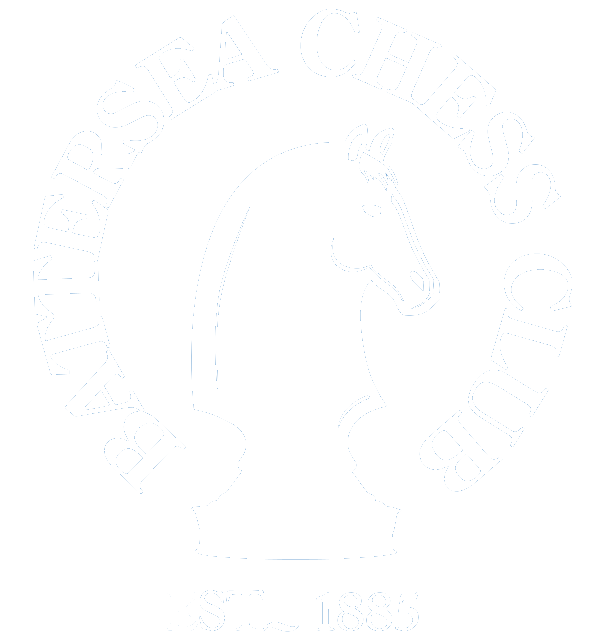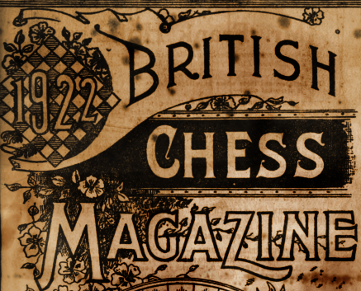Battersea Chess Club can today reveal new research proving beyond doubt that a century ago it was the victim of a shocking injustice in the London Chess League.
Club officials have consulted three of Britain’s top chess experts to examine a key game that was left unfinished on the final day of the 1921-22 season.
All three are adamant a bungled ruling that controversially handed the game, and therefore the match, to Brixton should simply never have happened. Many people are even saying filthy money changed hands…
The shady result meant Brixton won 10.5 to 9.5 and went on to become first division champions for the second time. Battersea, then one of the minnows, was denied a famous upset.
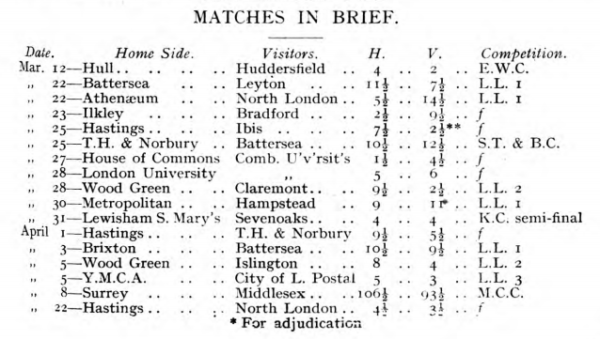
The decision, which was upheld after an appeal, also sparked an ugly row that sent shockwaves through the league and stoked the so-called “Brick-Bat” rivalry for 100 years. Members say even now echoes of the past are still present when the two clubs meet.
Even the genteel British Chess Magazine found its pages full of controversy as then-editor R.C.Griffiths was forced to defend himself from accusations of bias.

Printing the offending position, Mr Griffiths had come down firmly on the side of Battersea, saying the league’s decree was “astonishing” and, “Battersea lost a match which they probably, if they had their rights, should have won”. He was right.
Brixton then hit back with a lengthy, ranting reply from a “Mr Frank Steadman” who accused the journalist – who was also a sitting member of the league’s executive committee – of being “biased and unsportsmanlike”.
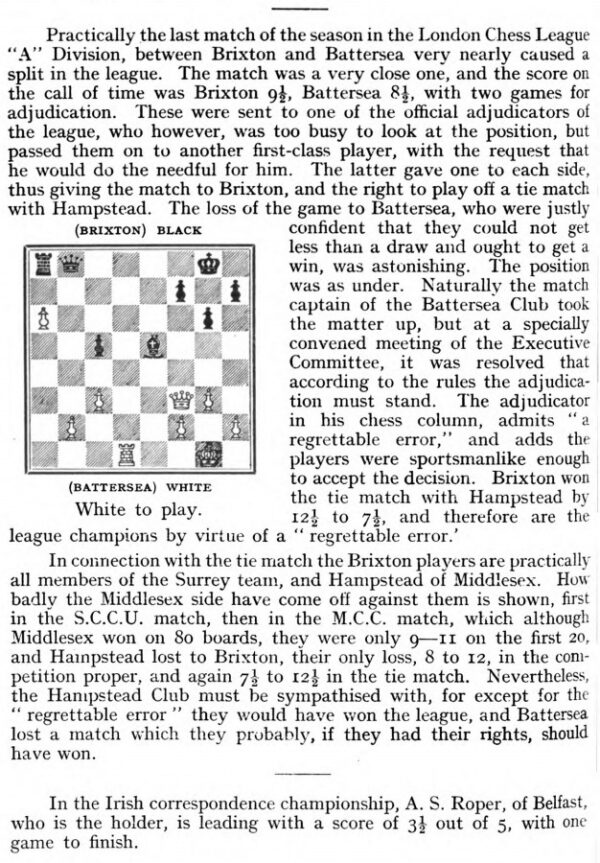
Mr Steadman, of Effra Road, Brixton, added that it would be “intolerable” for Battersea’s appeal to be heard and, invoking high-minded ideals of British sportsmanship, the club should simply accept the loss “even if we know it to be wrong”.
Now a former editor of the same magazine, which still survives in print today, defended his predecessor and stated in no uncertain terms that Battersea was robbed.
John Saunders, who has extensive experience in adjudicating games, was unequivocal.
“The guy who gave this a win for Black back in 1922 was an utter nincompoop who should have been clubbed to death with a hardback copy of Staunton’s Handbook. Probably the worst adjudication decision ever.”
John Saunders
He added: “After the blindingly obvious 1. Rd7 Black is struggling to hold. After 1…Qe8 (forced) 2 Qd5 Black’s completely tied down and after White plays a7, it’s really just a matter of time before something bad happens to Black. My decision – WIN FOR WHITE.”
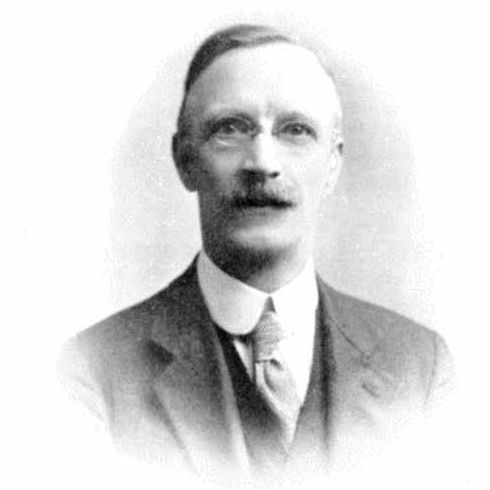
Mr Saunders was supported by International Master Malcolm Pein, an England team manager and The Telegraph’s Liverpool-supporting chess correspondent.
“I fear a great injustice has been done which forcibly reminds me of Liverpool Football Club’s travails at the hands of VAR these last two years. This is not because the two injustices have anything to do with each other, but more because I can’t think of anything else so night and day.”
IM Malcolm Pein
IM Pein added: “If I might capture the spirit of the moment from our more enlightened cousins in the USCF from across the pond, we must join forces and Stop The Steal. If that means storming the ECF HQ in Hastings so be it.”
Mr Pein was so exorcised he provided analysis “that demonstrates conclusively that even a jobbing member of Streatham 3rd team could win this position after a few pints”.
Another chess journalist, FM Tim Wall, concurred, saying simply: “Analysis seems fair enough to me. White’s doing well.”
All three experts have provided analysis showing how Battersea would have easily got the win needed to take the match. Modern chess analysis tools also back up that assertion with Stockfish 10 giving Battersea a lead of +1.5.
Battersea Chess Club has also conducted a poll of members of the wider chess community on Twitter. A poll found an overwhelming majority (65.3%) saw the position as a win for White, 22.4% a win for Black and 12.2% saying it should have been a draw.
More titled players also backed up the view that the position was most likely winning for White. They include IM Simon Ansell, IM Johann Alvarez and NM Fawole John Oyeyemi.
Reports of the episode suggest the decision was arrived at in somewhat murky circumstances.
League officials were asked to adjudicate the game from its position when play was stopped on April 3, 1922. It was one of two that night that needed adjudicating, but the other was awarded to Battersea and was not controversial.
Unusually in this case, however, the league’s regular adjudicator was “too busy” so both games were instead handled by a stand-in, “another first-class player” as he was described.
To Battersea’s horror, the unnamed assistant gave one game to each side – a shocking decision he then compounded publicly by admitting in a chess column elsewhere that he’d made a “regrettable error”.
Battersea protest
Battersea, represented by its redoubtable secretary G. Wernick, protested strongly and presented a winning line as evidence. Yet his protest fell on deaf ears.
The league convened a special meeting and refused to overturn the original decision. It said adjudications could not be appealed, despite Battersea’s claim that the original decision was not made by a league official.
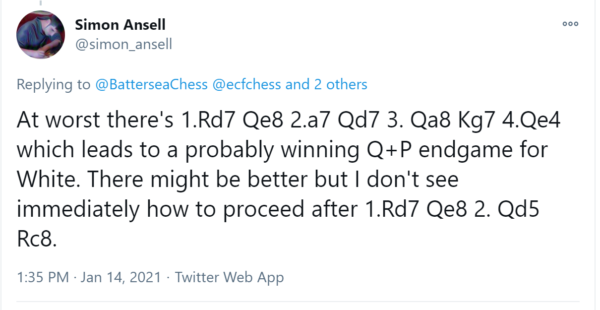
At the time, Brixton and Hampstead were the big boys of the division. Brixton had already won the Surrey Trophy that year for the third consecutive time – and 11th overall that year. They won every match.
The now-defunct Hampstead, meanwhile, had previously won the London Chess League four times in a row.
In comparison, Battersea was an up-and-coming club that was growing fast. In 1922 it had 119 members and was searching for a larger base. But it wasn’t until 1928-29 that Battersea finally got its hands on the Mecury Challenge Board, now renamed the Brian Smith Trophy.
Was it a stitch-up?
Did the league move to stop Battersea because it wanted a showpiece title play-off between its two biggest hitters? It certainly appeared so at the time.
It was after Battersea’s failed “appeal” – Mr Wernick called it a request for “reconsideraton” – that the battleground moved to the pages of the BCM. Mr Griffiths’ report was published in June 1922 and then this missive appeared:
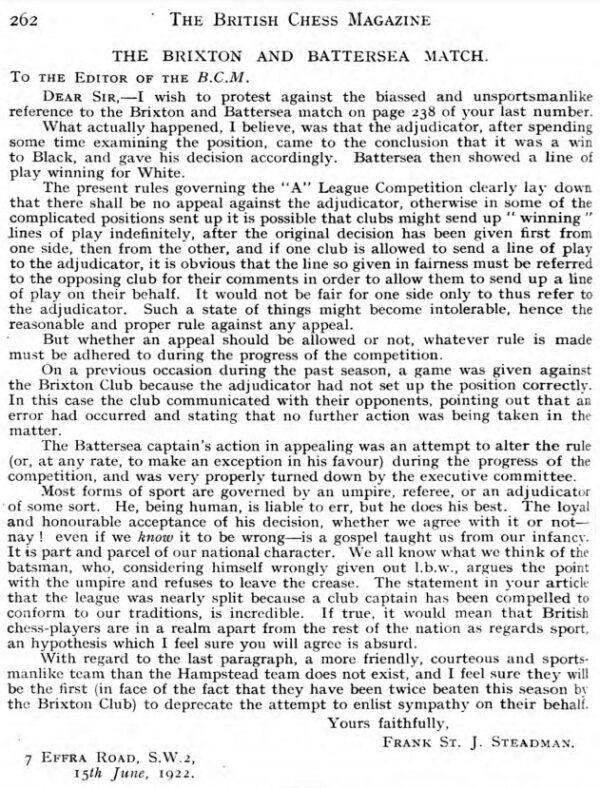
Following Brixton’s attack, the publication’s editor was forced to defend himself.
Mr Griffiths did not back down saying “an obvious error had been made” and suggested Brixton should have resigned the game, lost the match and never have won the championship.
Mr Griffiths also rubbished Mr Steadman’s weak analogy of a cricket umpire making a split-second decision saying that, in stark contrast to cricket, adjudicators in chess have plenty of time to arrive at the correct ruling.
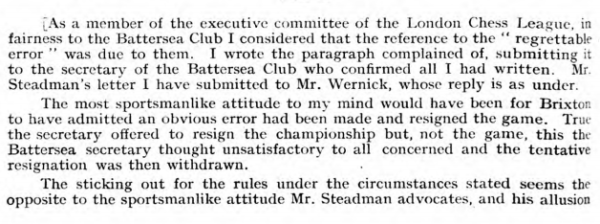

Mr Griffiths also included in the edition a response from Mr Wernick saying that when he was first notified of the decision he thought it must have been a “clerical error”.
However, the Battersea man did finally accept the league’s decision and – maintaining a stiff upper lip – offered “hearty congratulations” to Brixton on a “splendid performance”.
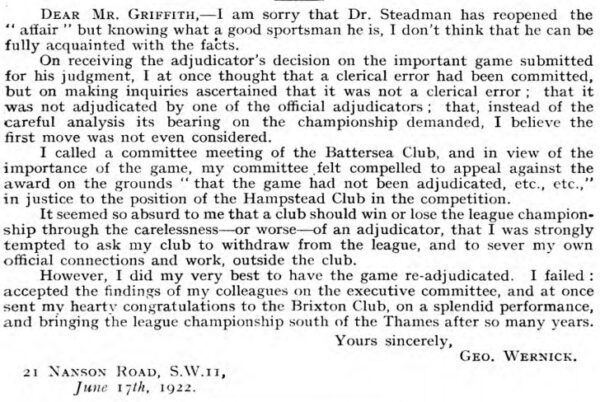
It brought an end to a sorry episode that was said to have “nearly split the league”. However, a bitter rivalry rumbles on to this day between Brixton’s successor, Streatham & Brixton, and the noisy neighbours Battersea.
This year Streatham & Brixton is celebrating its “150th birthday” – another disputed claim – and has challenged Battersea to a resumption of the old Brick-Bat derby match.
The Brick-Bat derby
Unlike the SW11 club, which has existed continually as one entity since its foundation in 1885, Streatham & Brixton only came into being as a single outfit in 1946.
“Why are we dredging this up?” Battersea secretary Leon Watson said. “This year the league stealers are celebrating their ‘150th birthday’. We put that in quote marks because the claim is questionable.
“Streatham & Brixton is in fact – as the name suggests – two clubs merged into one.
“The original Streatham and Brixton chess clubs formed ‘Streatham & Brixton Chess Club’ only 75 years ago as the various leagues they were involved in resumed post-war. They would have folded otherwise.
“But claiming that club is 150 years old is a bit like a married couple claiming their marriage has been going since the year the oldest of them was born. Ridiculous.
“Streatham & Brixton want to challenge us to a match to mark their ‘birthday’. I suggest we play from the 1922 position and see how confident of getting a win there are then!”
When approached for a comment on the rivalry, Streatham & Brixton secretary Martin Smith said: “There were occasional misunderstandings, but like two rival silver-backs, our two clubs huffed and puffed being careful not to shed your actual blood.
“But now you want to make it a battle for the soul of chess in the SW Inner-city we will rise to the challenge and see if we can’t teach (once again?!) some manners to the bother-boys (and maybe girls) of SW11.”
With thanks to Martin Smith, author of this 2015 post in the now-defunct The Streatham & Brixton Chess Blog. Without Martin’s dedication to clearing Streatham & Brixton’s name in this sorry affair, we would never have been inspired to right this wrong. Also to John Saunders who was so disgusted at the injustice of it all, he pointed me in the direction of old editions of the BCM. This report, while to my knowledge accurate, has been written with tongue firmly in cheek.
